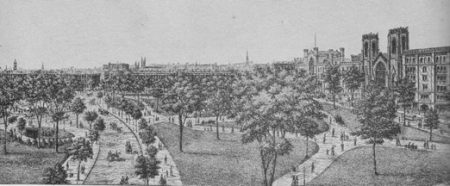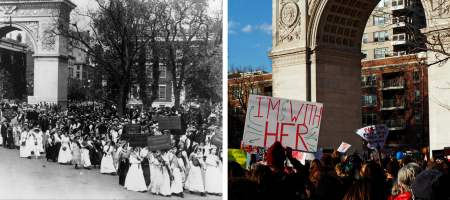
Washington Square Park most notably known for the famous arch was created in 1871. The park is situated in Greenwich Village in lower Manhattan, a small park with a big history. The site of the park has much history that has often been overlooked. What was there before? How did it come to be? These are many questions that some Americans have thought to ask themselves. Nowadays the park functions as a campus green, to celebrate, people watch, and enter into city life.
Before there was a monument honoring George Washington there was a cemetery. From the 1600s to the 1860s Washington Square site was used for the evolving needs of the New York people. During the American Revolution, the site was used as a cemetery to bury fallen soldiers and then later converted into a military playground.[1] During the Cholera epidemic of 1798 New York City declared an out-of-town burial ground on the present site of the park. With complaints from the New Yorker’s living in the immediate vicinity of the burial ground, the common council decided to prohibited burials after May 1,1825. [2]At this time in New York’s history Cholera was taking the city by storm. A viral infection spreading through the city like wildfire, affecting the poor population over the wealthy due to health and sanitary conditions. As a result, the wealthy New Yorker’s blamed the poor for the outbreak. Seeking refuge, the west end of the city became “safe”. Wealthier residents moved to Greenwich Village filling it almost overnight.[3] Greenwich village was then transformed into the thriving suburb we see today. To this day, more than 20,000 remains are buried underneath Washington Square Park. Every now and then some bones are uncovered when digging for renovations to the park.
Washington Square park went from burial ground to parade ground. “Parade grounds were specified public spaces within the city where voluntary militia companies could train.”[4] On February 27,1826 the Common Council approved the site to be used as a parade ground. This title insured that the land could not be divided into building lots and would preserve the open green space. The ground was named Washington Military Parade Ground on July 4, celebrating the fiftieth anniversary of the Declaration of Independence. After a year however, the Council ad declared that the irregular shape of the ground was not sufficient for the military use. The committee stated, “The whole Square ought forever thereafter to be and remain a Public square.”[5] The square was expanded to make the famous rectangle shape we see today. While expanding the park limits on the East side there was a Church burial ground. Church leaders reluctantly dug up the graves and moved them after being compensated. Washington Square Park has ties to graveyards that date back from before the park was announced up until the time it was being built.

Stanford White, when designing the arch, specified that the decorations would have a somewhat formal basis in the use of bunches of flags arranged as trophies in rather an architectural manner.[6] Stanford had a unique design in mind when creating the now famous arch. He envisioned elaborate design on the arch faces and thus turned to his friend Augustus Saint-Gaudiness. Augustus was at the time, the most highly regarded sculptor. As seen in the picture, the arch had very intricate designs. At the base of the arch stood two figures of George Washington. On the arch’s east side, it was intended for Washington to appear alert, as if watching over his army. On the opposing side, Washington is regarding looking into the future. Behind Washington two words can be seen, wisdom, and justice, as figures. Wisdom is represented by Athena and Justice is draped and crowned with a scale. Both of these figures can still be seen today, however over time and due to environmental factors, that caused wear and tear on the figures. [7] [8]

From the 1827 military parade ground to the 1871 plan for the square historians can see much differentiation. The early layout of the parade ground was symmetrical and incorporated diagonal paths. These paths would then merge into one geographic center where in 1852 a foundation was added. The later plan included gently curving pathways with grass areas that enlarged the foundation to 100 feet.[9] These is what can be seen today in Washington Square park. [10]

As the park was about to be completed, economic disaster hit. Financial depression affected Washington Square in many ways. The neighborhood surrounding the park declined in appearance. Wealthy families stayed in the area while poorer houses were converted into boarding houses. The depression of 1873 increased the tensions between social classes which in turn led to violence ensuing between labor workers and the bourgeoisie. During this time, the wealthy class became fearful toward the lower class and thus wanted to build more armories to ensure stability. [11] The top site to be turned into an armory was the newly renovated Washington Park. The park would serve as the headquarters with four cavalries. At this point in time however, parks were not allowed to be used for army use. In 1878 the National Guard presented a bill to amend that law allowing Washington Square park to be an exception. On June 1, 1878 the state legislature stated that, “public park known as Washington square or Washington parade ground shall….. be used in perpetuity for the public as a public park, and for no other use or purpose whatsoever.”[12] At the end of the day the armory was never built on the grounds and instead moved uptown on Park Avenue.
The park went through many phases and upgrades time went on. Electric and gas fixtures were placed in the park to extend the hours of park use. Benches and other commodities were placed in the park to encourage people to stay and watch children play. Roadways and other pavement allowed other people in the community to pass by and enjoy the amenities the park had to offer. People used the roadways so much that bikes had to be prohibited from the park. Later in 1871 the Park Department allowed and organized outdoor concerts. The tradition of outdoor concerts continued every Tuesday in the summer.[13] Further, the park included many public sculptures. There is a strong Italian presence in the statues, one commemorating Giuseppe Garibaldi, who was one of the best guerrilla generals in history. He sought asylum in the Untied States where he lived in Staten Island and then returned to Italy in hopes of reunification. Another bronze statue was installed commemorating Alexander Lyman Holley, an engineer, for a memory of all the technological advancements.
It happened on Washington Square- much history can date back to taking place on the historic park grounds. “Washington Square was often the launching site for mass demonstrations, an effective way to influence public opinion.”[14] During the early 1900s women were fighting to obtain rights. In 1915, two weeks before election day more than 25,000 women came out to protest on the park. The parade lasted three miles to demonstrate women’s equal rights. However the New York did not pass the law until 1917 and the nineteenth amendment was not passed until 1920. Washington park was also home to the Arch Rebellion and the Alley Festa. Rebels mounted on top of the arch wanting to declare the secession of Greenwich village from the America of big business and small minds.[15] The rebels called on President Wilson to protect the square and make a free and independent republic. This was all in fear of World War 1 and sure enough, three months later the United States entered the war in Europe. In addition to the radicals of the square there was the Alley Festa, a street fair that raised money for the Red Cross. There were different themed nights each with food and entertainment, some included elephant and camels for rides around the park. “The fair brought in more than $70,000 and sold over $540,000 in Liberty Bonds.”[16] Needless to say that Washington Square brought in many different audiences ranging from children who wanted to play on the grass, to adults who sat on the benches and walked the paths, and teens who came for entertainment and rode their bikes before it was banned. Washington square park is filled with history that dates back to before the park was built and what had once accompanied the ground. It is an important monument for many protests, architecture, and statues.

[1] Rick Beard and Leslie Berlowitz , Greenwich Village Culture and Counter Culture (New York , New York : The Museum of the City of New York , 1993).
[2] Ibid
[3] Ibid
[4] Emily Folpe, It Happened on Washington Square (Baltimore , Maryland: John Hopkins University Press , 2002), 67.
[5]Rick Beard and Leslie Berlowitz , Greenwich Village Culture and Counter Culture (New York , New York : The Museum of the City of New York , 1993).69.
[6]Emily Folpe, It Happened on Washington Square (Baltimore , Maryland: John Hopkins University Press , 2002), 128.
[7] Washington Arch in Washington Square Park. Date: 1937. Photographer: Edwards. WPA-FWP Collection, neg. 635b. NYC Municipal Archives
[8] Washington Accompanied by Vain and Valor, The City of New York.
[9]Emily Folpe, It Happened on Washington Square (Baltimore , Maryland: John Hopkins University Press , 2002),114.
[10] A Sketch of Washington Square Park in the 1880s, New York University
[11]Emily Folpe, It Happened on Washington Square (Baltimore , Maryland: John Hopkins University Press , 2002), 161
[12] Ibid 161
[13] Ibid 163
[14]Ibid 258.
[15] Ibid 262.
[16] Ibid 265.